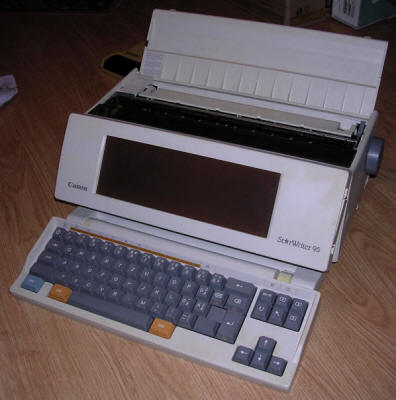Canon StarWriter 95
In 1980s microcomputers became more and more popular.
However, in parallel with office microcomputers a more limited computer
systems were sold as electronic typewriters, teletypes or accounting
machines. These systems were usually based on a small Z80 or (later) a
microcontroller and offered a limited set of programs in ROM. As the
last resort, some companies sold their CP/M machines in this role
supplying them with disk containing only text processor.
This machine is one of the later "word processors", containing not only
word processor software in ROM, but also a simple spreadsheet with
graphing capability ans image processing software to acquire scanned
images and insert them in text. Documents can then be saved on 3.5"
floppy disks.
Additionally, this machine has a built-in LCD screen for easy editing
and an ink-jet printer (with capability to connect an external one).
These devices were made since late 1980s even in early 1990s, but as
their compatibility with increasingly cheaper PCs was limited their
sales were not high. This particular unit is customized for German
market with localized keyboard and software, but using jumpers it is
possible to change locale. The ink-jet printer uses a typical Canon's
BC-02 cartridges, but with older ink keeping mechanism, so don't leave
the cartridge inside for longer time or it will leak.
There is also a real-time clock powered with 3 AAA batteries located
near a back-lit monochrome LCD screen.
| Manufacturer | Canon | ||
| Origin | USA | ||
| Year of unit | 1993 | ||
| Year of introduction | ??? | ||
| Type | Text processor | ||
| CPU: TMP90C841 RAM: 256kB? ROM: 2MB I/O: Keyboard, Backlit LCD, Centronics port for external printer, Expansion port, used for scanner interface, additional interface/connector (mini-DIN). Power: Built-in transformer-based power supply Additional capabilities: Battery-backed RTC, floppy drive for loading and saving results, built-in inkjet printer (Cartridge is a typical BC-02), beeper.
|
|||
My unit has been probably imported with used electronics from Germany and not sold, so it ended in recycling from where it was rescued. There is a scanner adapter with typical GSIF connector, I found that my spare A4Tech scanner works quite nice.
Floppy disks should be readable on a PC when the "Double-density hole" will be covered, but I haven't tried it.
I think programmers and Open Source developers should learn from such devices, running word processor, spreadsheet and monochrome graphics software in a hardware similar to better AVR-based Arduino, without gigabytes of RAM, GPU acceleration or CPU cores. Using assembly-optimized code, minimizing system requirements and going towards mathematically trivial solutions seems to be the better way to fix CPU security flaws than making the software bloated with workarounds and awaiting never-released "free" unaffordable, supercomputing architectures.
Jumpers for selecting locale (both language and keyboard) are present on the left side of mainboard, near contrast trimmer. Jumpers 11 and 12 are separate and they're connected. To set locale, cut or link JP10, 9, 8 and 7:
This is a copy of the original description of jumpers present on the mainboard. Notice that probably the X here means that the jumper is cut, not connected.
| Locale | JP7 | JP8 | JP9 | JP10 |
| USA I | ||||
| USA II | X | |||
| SPA | X | X | X | |
| SCA (?) | X | X | X | |
| DUT | X | X | ||
| FRA | X | X | ||
| LAT | X | |||
| QUE (?) | X | X | ||
| GER | X | X | ||
| ITA | X | X | ||
| UK | X |
However, the German versions may have different locale in ROMs, with e.g. more scandinavian languages (Norwegian, Danish, Finnish?) in some jumper settings.





